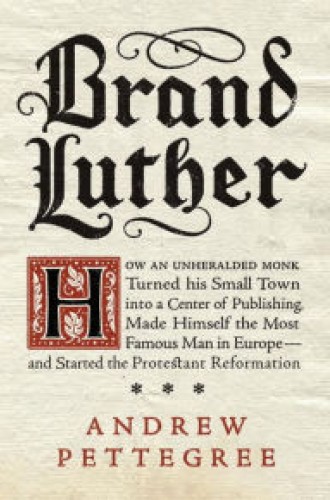Selling the Reformation
As the 500th anniversary of the Protestant Reformation approaches, we can expect the publication of many books to herald and accompany it. Some may be wearisome, but others will provide genuine insight into the origins of Protestantism and its meaning for the modern world. Brand Luther, by Andrew Pettegree, founding director of the St. Andrews Reformation Studies Institute at the University of St. Andrews in Scotland, falls into the latter category.
Drawing on his expertise in the history of printing and the book, Pettegree offers a novel approach to the story of Martin Luther and the Lutheran Reformation. The connection between printing and the advent of Protestantism is old news, but Pettegree breathes new life into the topic by demonstrating how deeply involved Luther was in the design and production of his printed works, how deliberate he was about promoting the print industry in Wittenberg and elsewhere, and how printers contributed directly to the astonishing success of Protestantism by promoting “Brand Luther”—the distinctive look of Protestant publications.
Read our latest issue or browse back issues.
Pettegree stresses that no one could have predicted this success in the opening decades of the 16th century. Luther was an unknown and unpublished monk-professor who worked at a minor university in a backwater town that did not even have a printing press until 1502. This press produced an unremarkable number of Latin books each year for the town’s scholars. All of this changed with the advent of Brand Luther.
In the midst of his theological spat with church authorities over indulgences, Luther developed a new form of theological writing that gave him unprecedented fame, revolutionized the print industry of his day, and catapulted Wittenberg to the center of the early modern print world. Beginning with his Sermon on Indulgences and Grace (1518), the Wittenberg monk-professor demonstrated an uncanny knack for writing theology in a way that appealed to the literate masses. Unlike the typical theology books of his day, Luther’s early works were clear, engaging, entertaining, and accessible (he frequently wrote in German). And above all, they were brief.
But there was more to Brand Luther than Luther’s new form of theological writing. The famous German artist Lucas Cranach, who also resided in Wittenberg, played a key role in revolutionizing the look of the evangelical pamphlet. Cranach had a monopoly on the production of illustrative and decorative woodcuts in Wittenberg, and he used this monopoly to create inexpensive but distinctive title pages for Luther’s pamphlets. The display of such artwork on title pages had previously been reserved for larger and more expensive books. The detailed and attractive artwork framed the title of the work along with the names Luther and Wittenberg, which were always placed in a prominent position within the frame. It was this new look, coupled with Luther’s new kind of theological writing, that formed Brand Luther.
Luther and Cranach’s early modern marketing campaign was a huge success. The inexpensive new evangelical pamphlets sold at astonishing levels. Pettegree states that German printers produced some 4 million copies of various works between 1520 and 1525, the heyday of the evangelical pamphlet. Luther was by far the most popular author, outstripping all others by a factor of ten and his opponents by a factor of 30, and his works of devotion were easily the most popular of his many publications. Printers grew rich off of this trade, and those outside Wittenberg copied Cranach’s title pages, in some cases retaining the name Wittenberg regardless of where the work was actually produced.
Luther welcomed new printers to Wittenberg and developed a very close working relationship with them, specifying exactly which printer he wanted to produce which work, and how each work should look. As Pettegree observes, Luther understood the “aesthetics of the book.” He did not, however, understand—or value—the economics of the book. Luther never made a pfennig from his publications.
After examining the early years of the Reformation, Pettegree explores the role printers played in the spread and institutionalization of Lutheranism through their production of church orders, hymnals, Bibles, commentaries, and catechisms. During his lifetime Luther sought to influence much of this production from his perch in Wittenberg, hoping thereby to exercise a kind of quality control over the Reformation’s founding documents. In this he was largely successful. By the end of the 16th century, Luther had become the most published person in Western history, Wittenberg had become a major center of printing in the German lands, and the Protestant Reformation had become a permanent reality.
Like Brand Luther, Pettegree’s book is clear, accessible, and engaging. It even has a distinctive cover. It does not deal with Luther’s theology in any depth, and Pettegree makes a few missteps on that front, but the vantage point of the print industry offers important new insights into Luther and the Reformation.
Pettegree even weighs in on the thorny question of whether Luther actually posted the 95 Theses on the door of the Castle Church in Wittenberg on October 31, 1517. On the basis of careful analysis of the print industry in Wittenberg and the early print history of the 95 Theses, especially the format that printers outside Wittenberg adopted in the earliest extant editions of the work, Pettegree makes a compelling case for an affirmative response. He provides important circumstantial evidence for the existence of a lost Wittenberg original that served as the model for the broadsheet editions from Nuremberg and Basel and was almost certainly posted on the door of the Castle Church. There is indeed historical warrant for observing Reformation Day on October 31 and for observing the Reformation’s 500th anniversary in 2017.






